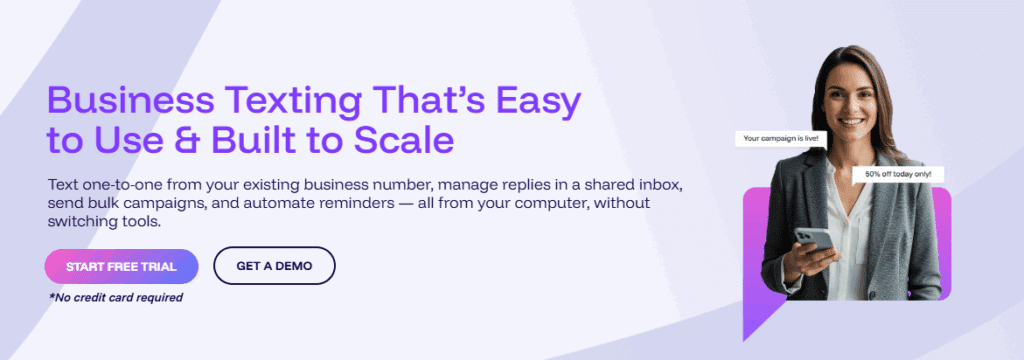
When Is the Best Time to Send Marketing Text Messages?
You might have the perfect offer and a solid contact list. But if your text reaches customers at the wrong hour, they might scroll past it or unsubscribe altogether.
Customers don’t check their phones equally throughout the day. They’re busy during work, resting at night, and only engage when it fits naturally into their routine.
Once you learn your audience’s daily rhythm, you can send messages that arrive at the moment they’re most likely to read and respond.
In this article, we’ll help you figure out how to identify the right timing when you’re texting for business marketing and discover ways to adjust your schedule.
Best Time of Day to Send SMS Messages
A text message sent at the right hour feels timely and helpful, while one sent too early or too late can feel intrusive and go unread. The difference between those outcomes often comes down to just a few hours.
Morning (9:00 AM to 12:00 PM)
This period is usually the best for promotional messages. People have settled into their day, opened their inboxes, and are more likely to respond. Promotions, appointment confirmations, and reminders perform well in this window.
Text marketing campaigns sent between 10 AM and 11:30 AM often gain higher response rates than those sent earlier or later. SMS subscribers are alert and have time to click links, browse offers, or visit stores before the day becomes busy.
Afternoon (12:00 PM to 5:00 PM)
The afternoon offers another opportunity for customer engagement. People review notifications during lunch breaks or before leaving work.
Messages sent during this window perform especially well for SMS campaign updates, limited-time offers, or flash discounts.
Retailers, restaurants, and salons see strong engagement between 1 PM and 3 PM. Your target audience will appreciate reminders they can act on immediately.
Evening (5:00 PM to 9:00 PM)
Evening hours can still work well for engagement, but timing is delicate. People are done with work and commuting, often relaxing and checking their phones before bed.
This makes 5 PM to 9 PM the best late window for reaching them. However, avoid sending bulk SMS marketing campaigns after 9 PM.
The Telephone Consumer Protection Act (TCPA) requires that promotional or marketing messages be sent only between 8 AM and 9 PM local time of the recipient. Anything sent outside that window is legally treated as a violation.
Best Days of the Week to Send SMS Marketing Campaigns
People’s moods, routines, and attention spans change throughout the week, and your results depend on fitting naturally into those rhythms.
Thursday
Thursday is one of the best days for engaging customers and preparing them for weekend activity. People start planning shopping trips, dinner reservations, or leisure time, so engagement stays strong.
Messages that perform best include early weekend announcements, loyalty rewards, or invitations offering exclusive access to deals and events. This is also a great time to make your message stand out.
Friday
Friday brings strong results for time-sensitive bulk SMS campaigns. People are relaxed, thinking about their weekend plans, and often in a spending mood.
Texts promoting dining, entertainment, and last-minute retail deals perform particularly well. Examples include “weekend-only” discounts, flash sales, and limited offers on food or drinks.
Avoid sending during weekday power hours, as people are commuting. They’re less likely to receive messages immediately during rush hour.
Mid-morning or mid-afternoon windows work best for group campaigns aimed at generating fast responses.
Saturday
Saturday is a popular day for text blast campaigns, especially for retail, hospitality, and beauty industries. Many customers shop, eat out, or book personal services during the day, which makes this an optimal time for lifestyle-driven promotions.
The best results usually come between 10 AM and 12 PM, when people start their day and check their phones before heading out.
Sunday
Sunday tends to have lower engagement for direct sales but performs well for gentle communication. You can use this day to send friendly updates, appointment reminders, or early previews of upcoming promotions.
Customers appreciate lighter messages as they prepare for the new week. Good examples include reminders for Monday or Tuesday, and early previews of upcoming promotions.
Best Calendar Dates to Send SMS Marketing Messages
Buying habits shift with the seasons, holidays, and even weather changes. Some months naturally encourage spending, while others are slower and better suited for building relationships or sharing updates.
Planning your campaigns month by month allows your brand to stay relevant and top of mind all year long.
Payday Periods (1st–5th and 15th–20th)
The start and middle of each month are consistently strong periods for engagement. People receive their salaries, pay their bills, and still have disposable income to spend.
This aligns perfectly with industry and customer habits that show higher spending confidence during these windows.
If you sell consumer goods, food delivery, or entertainment, you’ll benefit most from this timing. Sending between the first and third or between the 15th and 17th captures customers just as they feel comfortable spending again.
It’s also smart to send SMS blasts one day before payday as a reminder, positioning your offer as one of the first things customers think about when that paycheck clears.
February 13–14: Valentine’s Day Rush
The days leading up to Valentine’s Day bring an enormous surge in engagement. People are actively searching for gifts, reservations, and experiences.
This period is not only about romance but also about self-care and friendship, which broadens the audience for your SMS messaging.
Texts sent between 5 PM and 7 PM on February 13 perform best because many people finalize plans in the evening. Messages on the morning of February 14 also perform well for last-minute gift reminders.
Offers that focus on emotions, appreciation, or limited-time experiences achieve the highest conversion rates during this period.
You can also analyze data and compare SMS results to your email marketing campaigns to track key metrics and see how customers react across other channels.
May 8–12: Mother’s Day Shopping Window
The week before Mother’s Day consistently produces high open and response rates across retail, hospitality, and e-commerce sectors. Families are actively buying gifts, booking meals, and making arrangements for celebrations.
You can send between May 8 and May 12, ideally between 10 AM and 2 PM, when text subscribers browse during breaks or lunch. These off-peak hours help your SMS blasts stand out without competing against spam filters or crowded email marketing campaigns.
July 10–12: Mid-Year Sales Season
Mid-July is an underappreciated yet profitable stretch for marketing campaigns. It aligns with the shopping surge around Amazon Prime Day, which creates a chain reaction across industries.
Messages sent between July 10 and July 12 perform best when focused on urgency and exclusivity. Late morning to early afternoon works well for retail, tech, and travel-related promotions.
The mid-year timing also gives brands an opportunity to clear out old inventory while staying top of mind during slower months.
November 23–27: Black Friday and Cyber Monday Window
The period between November 23 and November 27 delivers the highest engagement and conversion rates of the entire year.
Customers are in active shopping mode, expecting deals, and ready to make immediate purchases. During these days, your SMS campaign messages can outperform email offers several times over if timed correctly.
The most effective messaging schedule includes one message the evening before Black Friday to create anticipation, and another early morning between 8 AM and 9 AM on the sale day itself.
Campaigns during this period should focus on short, direct language that emphasizes urgency. Cyber Monday texts on November 27 also perform strongly for online-exclusive deals.
December 18–24: Holiday and Last-Minute Shopping
The final week before Christmas remains one of the most profitable windows of the year for marketing campaign activity. Customers are making last-minute purchases, checking shipping cutoffs, and finalizing their gift lists. Engagement levels rise as the sense of urgency grows.
Messages sent between 10 AM and 2 PM perform best during this period, especially for offers tied to same-day delivery, in-store pickup, or gift card promotions.
Shoppers are also active during these hours as they coordinate plans and complete orders. After December 24, messaging should shift from sales to gratitude and post-holiday offers.
How to Optimize the Timing of Your SMS Campaigns
Perfect timing takes more than sending messages during business hours. Below are ways to optimize the timing of your campaigns so every text reaches your audience at the most effective moment.
Analyze Engagement Peaks
Every audience has specific hours and days when they are most likely to open, read, and act on a text.
You need to study your audience’s habits and customer preferences. Then, analyze response patterns to identify those windows.
You can use campaign analytics to see when engagement spikes. This provides valuable insights into what times drive the best click-through rates and conversions.
Once you pinpoint those engagement highs, you can build your sending schedule around them. Engagement changes with seasons, events, and even religious holidays, so review your results often.
Segment Your Audience
Not every subscriber checks their phone at the same time or responds to messages the same way. SMS segmentation allows you to tailor timing based on customer behavior and location.
Start by separating your audience based on location and time zone. A text that lands perfectly at 10 AM for one subscriber might arrive at 7 AM for another.
Segmenting by region prevents early-morning or late-night messages that frustrate customers and lead to higher opt-out rates.
You should also consider demographics and lifestyle patterns. Working professionals respond best during lunch breaks or early evenings, while younger audiences tend to engage later in the day.
You can also perform behavior-based segmentation by purchase history, such as frequent buyers, inactive users, or new sign-ups.
Frequent buyers respond well to time-sensitive deals, while inactive users engage better with softer reactivation messages sent midweek.
Automate Delivery Schedules
Instead of manually deciding when to send every message, SMS automation tools can analyze engagement data and send texts at the moment each subscriber. This approach helps your SMS campaigns stay consistent and data-driven without constant manual work.
Automated texting software like Textellent provides features that can track how and when recipients interact with your messages.
These systems learn from your campaign history by noting patterns like which hours see higher open rates and which time windows produce the most conversions.
Automating schedules also helps you manage large lists more efficiently. If you’re sending bulk text messages across different time zones, manual scheduling can quickly become chaotic.
SMS marketing automation makes sure every message arrives at the right local time, avoiding early-morning or late-night deliveries that could annoy your audience.
Test Different Send Times
A/B testing helps you understand when your audience responds to your SMS marketing campaigns. You can divide your list into two or more groups of similar size and behavior.
Then, send the same message to each group at different times, one in the morning for Group A and another in the afternoon for Group B.
Study which group opens, clicks, or replies more quickly. You can repeat this over multiple campaigns to see which time slot consistently performs better.
Testing should go beyond just hours. You can experiment with day of the week, message type, and event proximity. A promotional SMS might perform best mid-morning, while a reminder or confirmation may do better closer to the event.
Deliver Texts When Engagement Is at Its Peak—Try Textellent!
It’s ideal to know the best time to send SMS campaigns, as it can completely change how your customers respond to your campaigns.
Textellent goes beyond simple scheduling. Its automation tools, audience insights, and real-time analytics show you what works best for your business, down to the hour and day. You can track how each campaign performs, test different send times, and adjust your messaging strategy.
Customers expect timely, personalized communication. If you’re ready to stop guessing and start growing, it’s time to put your SMS campaigns on autopilot with Textellent.

Sign up for a free trial or request a demo consultation today!
FAQs About the Best Time to Send Marketing Text Messages
How early is too early to send a business text?
Texts sent before 8 AM are usually too early for most recipients. Early morning messages can interrupt personal routines and leave a negative impression.
You have to aim to start your SMS marketing messages between 9 AM and 10 AM, when people are fully active and more likely to check their phones willingly. Always respect local time zones and avoid messaging during quiet hours to stay compliant with regulations.
How often should you send marketing texts?
The ideal SMS marketing frequency depends on your audience and the nature of your SMS campaigns. Most businesses see good engagement by sending two to four times per month.
The best approach is to build a marketing strategy focused on quality over quantity. Each text should have a purpose, such as to remind clients about offers, share updates, or promote new events.
You need to keep your campaign data clean and consistent, and compare performance with your email campaigns to spot timing overlaps or message fatigue.
How effective is text message marketing?
While email has long been a staple of digital marketing, it doesn’t deliver the same immediacy as text messaging.
SMS marketing remains one of the most responsive communication channels. Data suggests that SMS has an open rate of around 98%, and most recipients read messages within minutes.
Many businesses also use SMS alongside marketing email campaigns to reach customers faster and maximize engagement. Conversion rates also tend to outperform email marketing and social promotions because of the instant, personal nature of texts.





